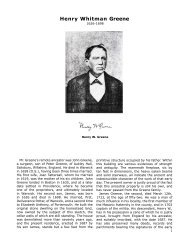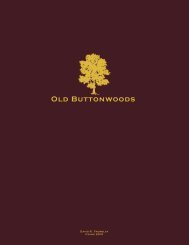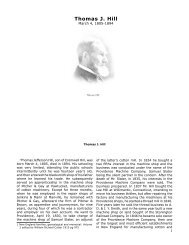August 2012 - Warwick Historical Society
August 2012 - Warwick Historical Society
August 2012 - Warwick Historical Society
Create successful ePaper yourself
Turn your PDF publications into a flip-book with our unique Google optimized e-Paper software.
Greetings from the board:<br />
www.warwickhistoricalsocietyonline.org<br />
SUMMER <strong>2012</strong><br />
As you all are aware we recently lost one of our own. Don D’Amato was a longtime supporter and<br />
participant in the activities of our society. Over the years he provided us with a written account of the<br />
history of <strong>Warwick</strong> as well as being our good friend. Both he and his daughter Terry Spencer have<br />
turned over to us most of his writings and photos for safe keeping. The bulk of the material has been<br />
scanned into our database and will continue to be available to all.
Don was the City Historian for about 20 years. Now the City Council has named his successor, Henry A L<br />
Brown. Henry is our Vice‐President and has also been a long time supporter and friend. We have been<br />
fortunate to have two such passionate historians as part of our family. Henry collaborated with Don on<br />
most of his books and hardly a week goes by that Henry comes into the office with historical material on<br />
<strong>Warwick</strong> and the Brown and Francis families that we are constantly scanning and adding to our<br />
database.<br />
Since our last newsletter we have been involved in a number of activities. In the Spring we had two<br />
presentations at the Library, Civil War Observance and Hazel Kennedy’s Pawtuxet. Both were well<br />
attended. In May we had our Annual Open House/Annual Meeting that was also well attended. A<br />
number of things occurred in June. We co‐sponsored an event with the Historic New England <strong>Society</strong> at<br />
the Arnold House in Lincoln. Robert Hunt Rhodes read excerpts from his book All for the Union on Elisha<br />
Hunt Rhodes (1842‐1917) of Rhode Island who served in the Union Army of the Potomac during the Civil<br />
War. The documentary by Ken Burns on PBS was based on Robert Rhodes grandfather’s original diary.<br />
We celebrated Madaleine Toy’s 101 st birthday at her Christopher Rhodes house in Pawtuxet with her<br />
daughter Polly Barey as hostess. Also in June the library held an event celebrating the role of<br />
quahogging in <strong>Warwick</strong>. We provided the images that were made into a permanent display for the<br />
foyer. The next time you are in the library stop and relive some of quahogging’s history. On <strong>August</strong> 9 th<br />
we had a display table at Oakland Beach National Night Out and Carnival to promote our <strong>Society</strong> and<br />
solicit new members.<br />
Our scholarship recipient this year, Matthew Rocheleau, completed his high<br />
school years at Toll Gate with a 5 th place academic ranking overall in his class.<br />
Matthew will be attending St Anselm’s College in the fall and is planning on<br />
becoming a physician. Our best wishes are extended to him.<br />
We recently changed our display at City Hall in the center hall case with material on <strong>Warwick</strong> Farms and<br />
Dairies. In addition to some of the photos we were able to find and a listing of all the known farms by<br />
village, there is our collection of old milk bottles from some of the dairies in <strong>Warwick</strong> and West<br />
<strong>Warwick</strong>. This display will remain until we change it in the fall to political history in time for the<br />
elections. Our case in the foyer continues to be maintained by Clouds Hill Museum in a collaborative<br />
effort.
Research requests are a large part of our ongoing activities. Some of our recent searches based on<br />
inquiries and interest are:<br />
All the material on farms and dairies<br />
The Hazard Hotel and the Hazard family of <strong>Warwick</strong> Neck mentioned below<br />
Selecting photos from our collection to be used in an EPA publication related to Greenwich Bay<br />
The material for the quahog display for the library mentioned above<br />
Information on obituaries of the Keenzel family<br />
Photos of the original Norwood School<br />
Lakewood planned community layout map<br />
Barton family genealogy and photos of the Barton farm<br />
Photos of our 1827 bedspread that was originally in an exhibition at the American Folk Art Museum.<br />
A member of the American Quilt Study Group is currently including our quilt in a current project<br />
involving quilts made before 1850 that will hopefully be published.<br />
In the last newsletter we were looking for information on the Hazard family and the Hazard Hotel.<br />
Thanks to the Schulte family and Lorraine Potter‐Cooper we can now shed light on this previously<br />
unknown property and family. The hotel was located at what is now 1000 <strong>Warwick</strong> Neck Ave. and is<br />
confirmed by its location on an 1889 map of the area.
One of our members, Shirley Nordquist, has been writing about the history of Pontiac to add to our<br />
database. See below for the first in a series she has written about early Pontiac settlers.<br />
We were recently made aware of the above objects. They were removed from the Pawtuxet River near<br />
the mill in Crompton. They are relatively heavy and appear to be made of concrete. The largest one in<br />
the upper right is approximately 2 inches in diameter. Does anyone know what they are, or what they<br />
were used for?<br />
We are planning a regional meeting of local historical societies to discuss common interests and issues .<br />
Hopefully this will promote a sharing of ideas that will encourage the growth and stability of all of us.<br />
We all require a constant infusion of ideas if we are to continue to provide the services that are a benefit<br />
to all and we need members to become involved and be active in all our activities.<br />
We purchased and installed an air conditioner in our library. It has been too hot up there in the<br />
summer. We can now work in relative comfort all year round. We have also been asking for estimates<br />
for future maintenance projects for the house. These include painting of the exterior, new storm<br />
windows and doors, added insulation for the attic and the crawl space under the kitchen, and bathroom<br />
repairs. In past years we have received a legislative grant to help supplement our income to be used for<br />
repairs and replacements. These grants have gradually been reduced each year until this year we have<br />
been cut out entirely. Many of you have not paid your dues. It is imperative that we receive that<br />
income if we are to continue to provide our services and maintain our historic house. If your label is<br />
highlighted in yellow we have not heard from you this year. Please make every effort to submit your<br />
dues. All donations are fully deductible under the tax code 501c3. If your dues are not paid we will have<br />
to remove your name from our newsletter mailing list.<br />
We haven’t forgotten about the <strong>Warwick</strong> Railroad book. There have been some technical problems<br />
related to publishing to be resolved. There is another book in the offing. Henry Brown and Alan Clarke<br />
have been working on a book about the Cole Farm. Again, as soon as it is published and available we<br />
will let you know.<br />
There are still two more library presentations to be done this year. They are Madaleine Toy’s photo<br />
album of early 20 th century Pawtuxet and John Carothers postcard collection of Rocky Point and Oakland<br />
Beach Amusement Parks. Dates TBA. Monitor our website and the library website in the fall for dates<br />
and times. Be sure to join us.<br />
The past isn’t dead, it isn’t even past—William Faulkner
EMIGRATION<br />
EARLY FAMILIES IN PONTIAC<br />
A family emigrated from Marbohemmet in Bone in Alvsborgslan in the spring of 1852 to<br />
search for happiness in the great, new land in the west. This was a farmer named Anders Petter<br />
Maganuson, his wife Britta Maria, and daughter Johanna Sophia. During the long and dangerous<br />
trip across the Atlantic Ocean in a sail vessel, the daughter became ill and died during the<br />
voyage. She was buried at sea.<br />
The family settled first in Charlestown, Massachusetts, where a daughter Emely was<br />
born. Shortly thereafter they moved to Union, Connecticut, where Mr. Magnuson found work in<br />
a sawmill. Twin daughters were born there, but one of them died at a young age, and the other,<br />
Jennie, survived. Sadness befell them again when their house in Connecticut burned, and their<br />
worldly possessions perished in the flames. Thereafter they moved to Providence in 1857.<br />
When war broke out in 1861, Mr. Magnuson enlisted in the First Rhode Island Artillery<br />
Regiment, and was involved in many bloody battles. After the war ended, he returned to Rhode<br />
Island and rented a farm in the Posnegansett section of <strong>Warwick</strong>, near Spring Green. He later<br />
bought land in the Hillsgrove area, and lived there until his death. His daughters Emely and<br />
Jennie were married to two sons from the Hallin family. When the Swedish Lutheran Church<br />
was organized in Pontiac in 1874, they were received as members there. Mrs. Magnuson, born<br />
in Hossna on September 9, 1882, died on January 12, 1894. Mr Magnuson, born in Timmele<br />
(Timmelhed) on September 14, 1814, died on October 11, 1897. Both are buried in the church<br />
yard at St. Paul Lutheran Church in <strong>Warwick</strong>.<br />
The Magnuson family has perhaps been the reason more than any other that so many<br />
people have emigrated from the province of Vastergotland to Rhode Island. Soon after Mr.<br />
Magnuson settled in the Spring Green area, he began to think that on this side of the Atlantic<br />
one could find a good living for many in Sweden who were left behind there by friends and<br />
relatives, and were waiting for the deciding word from him that they also might come here.<br />
From Hossna, Bone, Timmele (Timmelhed) and Dalum and other neighboring communities they<br />
came, a single family or individual, one after another. As soon as they had become acclimated to<br />
their new environment , they sent for their acquaintances, and this continued for several years.<br />
One of the first who on Mr. Magnuson’s advice came here was Anders Bengtson from Boras,<br />
who with his wife came to the Magnusons in 1865.<br />
Anders Bengtson found work in the textile mill in Pontiac, and in a short time settled in<br />
this village, becoming the first Swede to live there. It later became a Swedish village. The<br />
Bengtson family left their sons in Sweden, namely Albert, Herman, and Axel, and also a daughter<br />
Emma, but within three years they sent for them. Mrs. Magnuson’s sister Johanna and her<br />
husband Carl Johan Persson were the next who joined relatives in Rhode Island. It was the<br />
spring of 1866. Like the Bengtsons, they lived at first with the Magnusons, but then moved to<br />
Pontiac, where both the husband and the wife found work at the mill. Mrs. Persson was the
first Swedish woman who earned a day’s pay at the mill. Since she at first did not understand a<br />
word of English, it was very awkward for her, but one of the brother’s young daughters, Emely,<br />
now Mrs. Joseph Hallene, stayed with her as she worked and served as Mrs. Persson’s<br />
interpreter. The following year the Perssons sent for their sons that they had left behind in<br />
Sweden, and the older sons Alfred and Gustaf arrived in <strong>August</strong> of 1886, and the younger sons,<br />
Sven and <strong>August</strong>, arrived in December. In the spring and summer of 1868, the influx of Swedes<br />
into Pontiac began in earnest. Verner Johnson and his wife Kristina came from Jonkoping,<br />
Anders Gustaf Johnson from Dalum, and Claes Johan Ahlstrom from Timmelhed. In 1875, the<br />
town of <strong>Warwick</strong> had recorded 218 persons from Sweden, which was double that of Providence.<br />
The years 1868 and 1869 are rich in sad memories for the Swedish people because of<br />
crop failure which struck a large section of Sweden. This in part hastened the immigration to<br />
America during this time. Steamships were now also in full use, and made the trip over the<br />
ocean quicker and more comfortable than during the time of the sailboats of the 1840s when a<br />
previous wave of immigration had occurred.<br />
Anna‐Lena Hultman of Hossna, Vastergotland, tells of life in the rural area of her home<br />
town in the late 1800s in the book “Bygd och Gardar kring Galtasen,” a collection of stories by<br />
the Hossna Hembygdsforening. This period was a time of extensive emigration. Some of the<br />
reasons were overpopulation in the rural areas, especially among the “torpar class;” low wages;<br />
hard work; shortage of food; and the inability to see any light in the future in this community.<br />
There was also a lack of industry in this area.<br />
From 1843 to 1901, 578 people moved from this area, the largest number occurring in<br />
1882. At that time, the main reason was crop failure, especially with potato cultivation, which<br />
was an important source of income. Also there was rising propaganda for travel to America. At<br />
one point, eleven families from Hossna traveled on the same boat. The emigrants traveled by<br />
horse and wagon to Goteborg; boarded a mail boat en route to Hull, England; a train to<br />
Liverpool; and then a ship to New York. Many continued on to Providence, Rhode Island.<br />
Often one member of the family borrowed money for the cost of the ticket. Once in<br />
America, that member saved enough money to bring over another family member, until the<br />
whole family was reunited here.<br />
Hultman, Anna‐Lena. “Emigration.” Bygd och Gardar kring Galtasen. Ed. Hossna<br />
Hembygdsforening. Boras: Sjuharadsbygden Press, 1979.<br />
Osterberg, J. S. Svenskarna I Rhode Island. Worcester: Svea Press, 19<br />
Editor’s Note: The spelling in this article is original Swedish, not typos.






